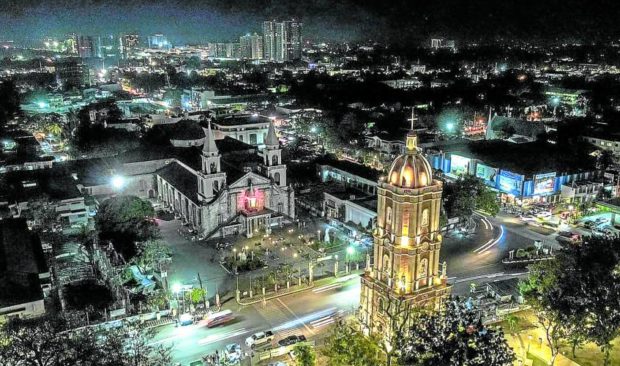Restored centuries-old Jaro bell tower reopens

RELIGIOUS LANDMARK The newly restored Jaro belfry towering at Graciano Lopez Jaena Plaza stands across Jaro Cathedral in Iloilo City in this photo taken last week. —PHOTO COURTESY OF ILOILO CITY MAYOR JERRY TREÑAS
ILOILO CITY—After a year of restoration, the National Historical Commission of the Philippines (NHCP) has turned over the imposing Jaro belfry to the local archdiocese and government officials on Sunday, allowing Ilonggos to show off with pride this centuries-old landmark.
The three-story, free-standing belfry tower, which stands across the equally imposing Jaro Cathedral, features new carillon bells, reinforced and reconserved stone masonry, new windows and lights.
Iloilo City Mayor Jerry Treñas, in an interview, said the restoration of the belfry showcased the city’s rich cultural heritage as well as its desire for more green spaces.
“We cannot move forward unless we look back to where we came from. That is the reason why we are spending so much of our energy and our resources to fix our plazas,” he told the Inquirer.
“It is still as relevant today because we want to provide green public spaces for the people, or what we call the public realm,” he added.
Article continues after this advertisementBeautification
The restoration of the belfry, which rises 29 meters from the ground, was part of the NHCP’s P20-million budget for the beautification of the Jaro Plaza, which will be renamed Graciano Lopez Jaena Park in honor of the Jaro-born journalist and reformist, and founder of La Solidaridad.
Article continues after this advertisementA new shrine was also constructed to honor Patrocinio Gamboa who was known for hoisting the Philippine flag in the nearby town of Santa Barbara—the first outside of Luzon.
While the belfry was already turned over to the Archdiocese of Jaro, which owns the structure, it would not be open to the public yet.
Treñas said local government officials will meet with the local church leaders to allow the public to enter the structure and come up with the necessary rules for its maintenance.
Watchtower
The Jaro belfry, also known as Campanario de Jaro, is located across the Jaro Metropolitan Cathedral of the Our Lady of the Candles in Jaro District here.
It is one of the few belfries in the country that stood apart from the church that it is a part of.
The belfry, which was built in 1744 and made of bricks and limestone blocks, served both as a religious structure and as a military watchtower against invaders during the Spanish colonial period.
On July 17, 1787, the belfry was heavily damaged by a strong earthquake. The reconstruction only started in 1833 under the supervision of Fr. Jesse Alvarez, an Augustinian friar.
Between 1833 and 1881, another earthquake damaged the belfry tower, prompting Msgr. Mariano Cuartero, the first bishop of Jaro, to have it restored.
On Jan. 25, 1948, the belfry was again destroyed when an earthquake shook the entire Panay region.
In the 1990s, the reconstruction of the belfry started under the supervision of the NHCP.
It was supposed to have a viewing deck and a tourist center but these did not materialize due to a conflict with the Archdiocese of Jaro.
Heritage zones
In February 2022, the belfry was again restored under the NHCP. It includes the restoration of its original design with statues that depict the four cardinal virtues of the Catholic Church: prudence, justice, fortitude and temperance
The budget for the restoration of the belfry, including the beautification of the plaza where it stands, was enabled by Republic Act No. 10555, which designated several historical locations in the city as Cultural Heritage Tourism Zones.
These included the Jaro Cathedral, the Jaro Plaza complex, Molo Church, Iloilo City Central Business District, Fort San Pedro, and the Molo Plaza and Plaza Libertad complexes. INQ